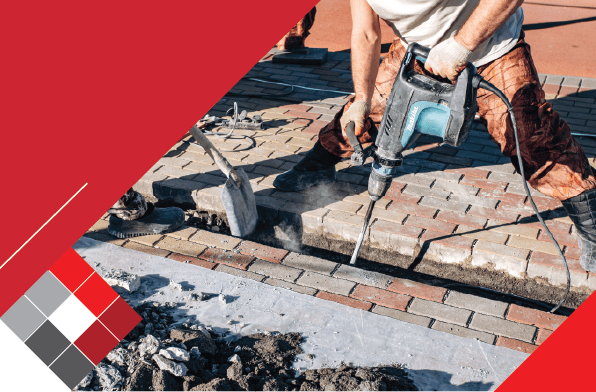Don’t let a poorly installed paving bring you headaches. Take a closer look at these common issues that can arise during paving installation.
Let us guide you in avoiding these problems as much as possible.
1. Cement Staining
Cement staining is a common problem that can occur on concrete surfaces. It is caused by the absorption of liquids or other materials into the concrete, which can then discolour the surface.
Curing is the process of allowing the concrete to dry and harden properly. If the concrete is not cured properly, it will be more susceptible to staining.
If a spill occurs, be sure to clean it up immediately. This will help to prevent the liquid from absorbing into the concrete.
2. Paving Alignment
There are a number of things that can be done to avoid crooked lines in paving.
One important step is to use a string line to mark out the desired alignment before starting work.
The string line should be taut and level, and it should be checked regularly to make sure that it does not move. Another important step is to use the correct tools and materials.
For example, a laser level can be used to ensure that the surface of the paving is level, and a chalk line can be used to mark out the desired alignment.
3. Sealants
There are many different types of paving sealers available, so it is important to choose one that is designed for the specific type of paving material you have.
For example, if you have concrete pavers, you will need to use a concrete sealer.
Capestone supply a wide range of sealers.
4. Issues with Grouting
Grout failure can occur due to a number of factors, such as improper grouting techniques, poor substrate preparation, inadequate grout strength, excessive movement in the substrate, chemical exposure, and time.If grout fails, it can be unsightly and can also allow water and other contaminants to seep into the joint between the tiles, which can lead to further damage.
5. Sub-base/Earthworks
The foundation of a paved area is crucial, and failure to properly prepare the sub-base can lead to irreversible issues. Ensure that the earthworks are executed correctly to prevent paving failure.
6. Drainage
Improper drainage during installation can lead to ponding and water infiltration, causing potential sub-base failure. Ensure correct drainage practices are followed for durable paving.
7. Handle with Care
Capestone cobbles and flagstones require careful handling to prevent chipping and breaking. These pavers differ from conventional bricks and demand special care.
8. Compaction
Insufficient compaction of the bedding layer can cause pavers to sag and result in water pooling. Adequate compaction is essential to maintain the integrity of the pavement.
9. Fine Details
The beauty of Capestone paving and tiling lies in the meticulous attention to detail during installation. Neglecting these details can compromise the overall aesthetic appeal of the paved area.















